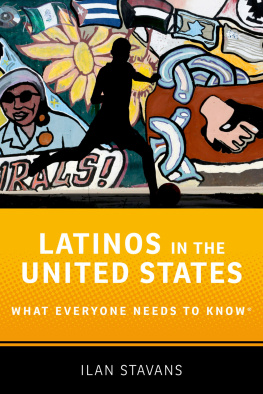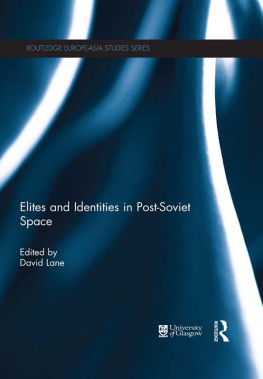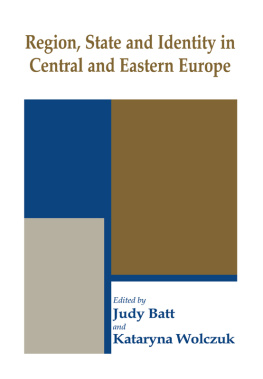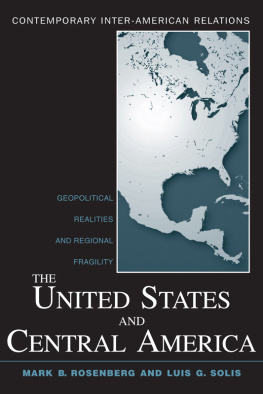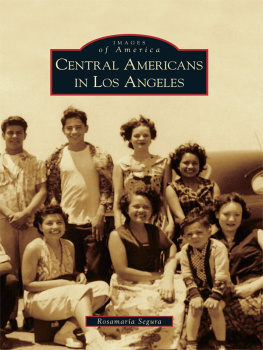Constituting Central AmericanAmericans
Latinidad
Transnational Cultures in the United States
Matt Garcia, Series Editor, Professor of Latin American, Latino and Caribbean Studies, and History, Dartmouth College
This series publishes books that deepen and expand our understanding of Latina/o populations, especially in the context of their transnational relationships within the Americas. Focusing on borders and boundary-crossings, broadly conceived, the series is committed to publishing scholarship in history, film and media, literary and cultural studies, public policy, economics, sociology, and anthropology. Inspired by interdisciplinary approaches, methods, and theories developed out of the study of transborder lives, cultures, and experiences, these titles enrich our understanding of transnational dynamics.
For a list of titles in the series, see the last section of the book.
Constituting Central AmericanAmericans
Transnational Identities and the Politics of Dislocation
Maritza E. Crdenas
Rutgers University Press
New Brunswick, Camden, and Newark, New Jersey, and London
Library of Congress Cataloging-in-Publication Data
Names: Cardenas, Maritza E., author.
Title: Constituting Central American-Americans : transnational identities and the politics of dislocation / Maritza E. Cardenas.
Description: New Brunswick, New Jersey : Rutgers University Press, [2018] | Series: Latinidad: transnational cultures in the United States | Includes bibliographical references and index.
Identifiers: LCCN 2017035055 | ISBN 9780813592831 (cloth : alk. paper) | ISBN 9780813592824 (pbk. : alk. paper) | ISBN 9780813592848 (epub) | ISBN 9780813592862 (Web PDF) | ISBN 9780813592855 (mobi)
Subjects: LCSH: Central American AmericansEthnic identity. | Central AmericansUnited StatesSocial life and customs. | Hispanic AmericansEthnic identity.
Classification: LCC E184.C34 C37 2018 | DDC 305.868/073dc23
LC record available at https://lccn.loc.gov/2017035055
A British Cataloging-in-Publication record for this book is available from the British Library.
Copyright 2018 Maritza E. Crdenas
All rights reserved
No part of this book may be reproduced or utilized in any form or by any means, electronic or mechanical, or by any information storage and retrieval system, without written permission from the publisher. Please contact Rutgers University Press, 106 Somerset Street, New Brunswick, NJ 08901. The only exception to this prohibition is fair use as defined by U.S. copyright law.
www.rutgersuniversitypress.org
For Jude, Winnie, and my abuelita Cruz
Contents
Today, some of us of Central American background are becoming scholars. With more Central American programs we will be writing our own literature, form our own discourse, shape our own culture, and forge our own identity.
Nora Hamilton and Norma Stoltz Chinchilla, Identity Formation among Central American Americans
We are often asked why we want to distinguish ourselves as Central Americans. Why not just join or blend into other cultural and political movements that have more established visibility and community support? Many of us are a part of community spaces where we work as a part of or in solidarity with communities of color, queer folks, immigrants and educators. But we feel the need to create a space of our own U.S. Central American voices, which are still rarely heard.
Maya Chinchilla, Welcome to Epicentroamerica: An Anthology
In her seminal work, Ethnic Labels, Latino Lives (1995), Suzanne Oboler explores the complex ways in which individuals of Latin American descent (dis)identify with ethnoracial categories in the United States. Obolers work is of particular importance for Central American scholars, as it was one of the first to feature the perspectives of three different Central Americans living in New York: Charles, a self-identified Garifuna from Honduras; Dolores from Guatemala; and Rosa from El Salvador. Oboler notes that these new immigrants, along with others, tend to reject the label Hispanic (and perhaps, by extension, Latina/o). In this example, we see that Rosa oscillates between using regional and national terms as a primary axis of identification. She initially positions herself within a broader collective, Central American, then later proclaims that she is Salvadorean, and finally concludes by stating that she is a Central American from El Salvador. Such ordering suggests that Rosa might equally value her Central American identity as she does her national one. Her answer therefore reveals not only the ways in which some subjects from the isthmus adopt multiscalar forms of identification but also how they often disidentify with other categories such as Latina/o, or in this case, Hispanic.
While Rosa in New York asserted her Central AmericanSalvadoran identity, on the West Coast of the United States, a flourishing of institutions, community organizations, university student groups, and everyday individuals had already begun to use Central American as an ethnic organizing principle and mode of identification.backgrounds came together and not only created their own student group under the rubric Central American but, in addition, lobbied to create an academic program under that name highlights the usage of a new type of diasporic ethnic sociocultural subject that has entered the U.S. American lexicon of identity politics and is the focus of this book: Central American.
Indeed, the development of spaces like CAS by students self-identifying as Central American challenged the then prevalent notion of a lack of [Central American] identity politics, as well as dichotomies often promulgated in Latina/o discourse. Consequently, one either chooses their particular national community or, when in need of political visibility, usurps the pan-ethnic identity of Latina/o.
With this in mind, we can see how the self-designation of Central American by subjects throughout the United States can be read as a rejection of this Latina/o dyad. In the case of CAUSA, for instance, rather than opting to imagine themselves as part of a larger community formation by unifying under the term Latina/o, or positioning themselves within a more specific national subgroup like Guatemalan or Honduran, they asserted an alternative option. The construction of a Central American identity in the U.S. diaspora problematizes this dichotomy between the national and pan-ethnic and also undermines the notion that the category of Latina/o encapsulates the social experiences of U.S. Central Americans. William Flores and Rina Benmayor have suggested that Latinidad as a rubric can provide a type of cultural citizenship, which functions as an alternative form of belonging for subjects who are usually excluded from U.S. American discourses of culture and citizenship.
The examples of Rosa, CAS, and CAUSA therefore reveal that for some subjects within the temporal demarcation designated as the Hispanic era (post 1980s), the shift toward using Hispanic or Latina/o as labels did not usher an immediate mode of identification but instead enabled the production of another Such a view of Central America as a site of belonging is demonstrated by the following response provided in Nora Hamilton and Norma Stoltz Chinchillas recent work (2013), where one of their interviewees named Mario explains what it means to be Central American:


